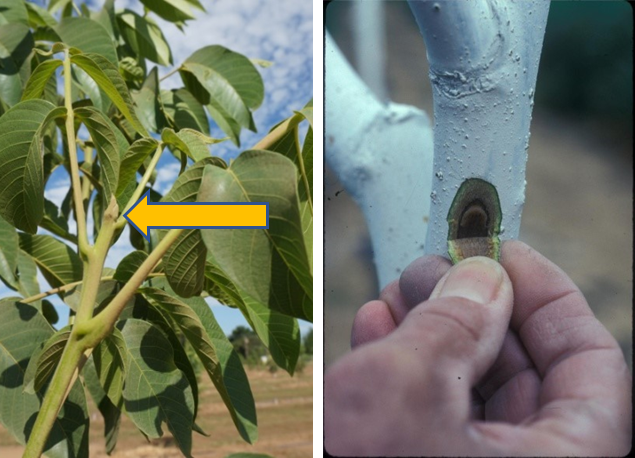Updated September 2022. Originally posted October 2021.
Luke Milliron, UCCE Farm Advisor Butte, Glenn, and Tehama Counties
Janine Hasey, UCCE Farm Advisor Emerita
With sudden autumn freeze damage occurring in three of the last four years, preparing for these freeze events needs to be a regular part of every walnut grower’s summer and fall orchard operations.
How to reduce future damage.
- For mature trees, don’t apply any additional nitrogen (N) from September onwards to prevent tender new growth that is most vulnerable to freeze damage. For young trees, it’s best to cut off N applications by mid-August.
- For young trees, withhold irrigation starting in early to mid-September, waiting to resume irrigation until after a terminal bud (left photo) is set on the trunk. After the terminal bud has set, resume irrigation to avoid tree stress and defoliation, without the fear of pushing tender new growth.
For bearing trees, terminal buds may set as a positive side effect of the water cutoff done ahead of harvest to avoid shaker injury.
- Maintain short groundcover during autumn frost season, beginning mid-October. Keeping groundcovers cut to 2 inches or less during frost season allows sunlight to reach the soil surface, increasing soil heat storage for a warmer orchard through the night. Recently cultivated soil has many air spaces, low heat storage capacity, and low heat conductivity resulting in colder minimum temperatures. The ground surface must be moist for bare ground to be the warmest (see steps 4 and 5). Be familiar with the infiltration rates of your soils to be able to better plan for irrigations for freeze mitigation.
- Trees with adequate soil moisture are better able to withstand low temperatures without damage than trees in dry soil since water-filled spaces in the soil conduct and store more heat than empty airspaces. If there has not been adequate rainfall by the end of October, irrigate both young and mature orchards so the soil surface is kept moist going into November. To know if rainfall is meeting this moisture need or if irrigation is necessary, compare rainfall totals with ET, and monitor soil moisture levels by hand or with sensors. These top 12 inches of soil are the most important for freeze mitigation and should be kept at field capacity (not saturated/ponding) if possible. Either a dry surface crust on one extreme or a frozen sheet of ponded water on the other extreme will both hinder the re-radiation of stored daytime heat during the night.
- Continue to actively monitor soil moisture and freeze predictions in November and December (until trees are acclimated to frost – see note below). Since frost is variable depending on location, monitoring each block remotely with a frost alarm makes good sense. If a freeze is predicted and the soil is dry, it should ideally be wetted 2 to 3 days before a freeze event to fill the air spaces so the soil will store more heat. Light irrigation to moisten a dry soil surface the morning before a frost will help obtain the greatest heat storage for re-radiation at night (as long as there is no standing water during the freeze event).
- Some growers with the ability to actively irrigate during sudden autumn freeze events have reported great success in preventing damage. We know from work in almonds that active frost protection can achieve as much as 4 degrees protection with solid set irrigation if your system can run 40 gpm/ac. With micro-sprinkler irrigation, 1-2 degrees of warming can be achieved with at least 30 gpm/ac. Running a drip system during a frost may provide very slight benefits due to radiation from freezing water in the wetted area beneath the trees.
The best approach to escape damage from a fall freeze is to have frost alarms ready and turned on by October 15, completely rehydrate trees after harvest, and actively irrigate during frost events.
If you suspect freeze damage occurred, cut into the branches shortly after the freeze event and check the tissue for drying or browning (photo 2). Swift action in the week after a freeze event can significantly decrease damage. Sunburn after freeze can further damage tissue on the southwest side of the tree. Paint the southwest side of damaged trees with 50% diluted (1:1 water to paint) white interior latex paint. Painting up to a week after the freeze event can reduce additional damage by half or more. You can learn more about freeze recovery in our article 2020 Walnut Freeze: Road to Recovery.
When do you no longer have to worry about preparing for the next freeze? Fully dormant mature healthy trees can tolerate temperatures to the low 20’s (°F) or below. However, walnut trees must first fully acclimate to withstand severe freeze events. We believe walnuts acclimate by having the first frost events in autumn with lows near 32° F, or just below. However, we do not know how many (one, two, three, etc.) freeze events are required to acclimate trees in autumn. If the soil is dry ahead of the third, fourth, and maybe additional freeze events – it’s better to irrigate and be safe if you can do so. In addition, consider keeping up your freeze response program longer into fall or early winter for younger orchards with lots of current season’s growth.

Left: Withhold irrigation until a terminal vegetative bud sets on the trunk. Right: After a severe freeze event cut into the southwest-facing trunk, looking for dark brown discoloration of the cambium (photos: Janine Hasey).
As growers were reminded this past April, autumn is not the only time that walnuts can be damaged by a freeze event. Learn more about preparing for an extreme spring frost at SacValleyOrchards.com.


Leave a Reply